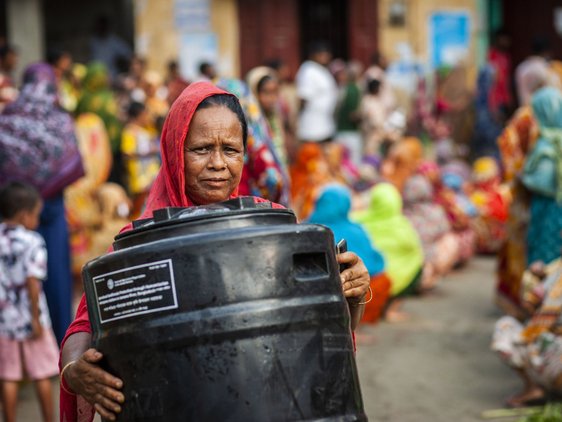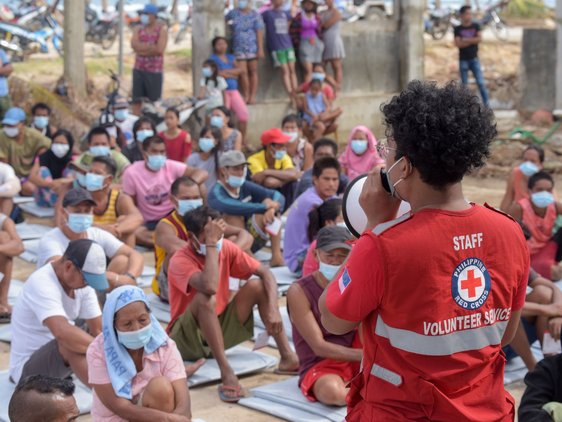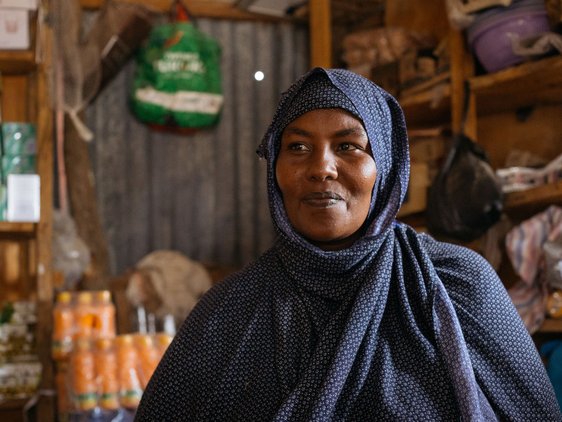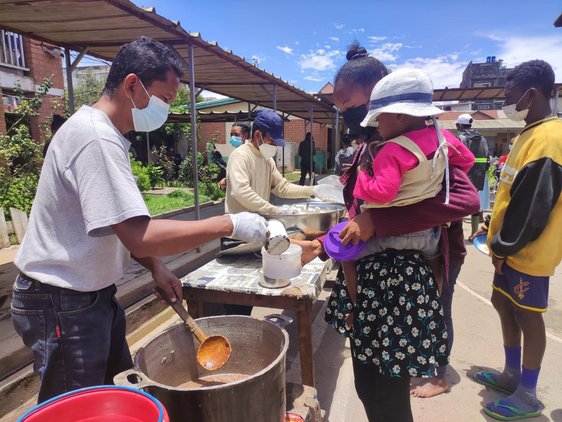Acting early before disasters hit: how business help scale up anticipatory action
In light of the International Day for Disaster Risk Reduction, and its focus this year on early action, we are showcasing the importance of anticipatory action, a framework that builds on early action activities to make humanitarian response faster, more efficient, and more dignified.
What if we invested in protecting people from the impacts of hazards, rather than waiting for the worst to happen and then responding? That’s the guiding principle of anticipatory action, an approach to disaster risk management that is rapidly gaining traction around the world.
Thanks to improved weather forecasts and technology, we can predict extreme weather events with more accuracy than ever. This enables a fundamental shift in how we approach crises: moving from reactive to proactive - but there’s still a long way to go to prevent the worst impacts of weather-related disasters.
Our collective experience shows that we need to massively scale up investment in anticipatory approaches, and better engage the private sector to ensure access to early action for all.
Play Video

Anticipatory action is gaining momentum in the humanitarian sector
Anticipatory action is defined as “acting ahead of predicted hazards to prevent or reduce acute humanitarian impacts before they fully unfold”. The innovative aspect of this approach - which combines pre-agreed financing with early warning triggered by weather information - has gained popularity since the first pilot activities were implemented in 2014. Anticipatory action projects are now being developed in about 70 countries. Recent examples include forecasted floods in Mali, Niger and Typhoon Noru in Viet Nam.
As the number of countries and agencies adopting this approach grows, so too does the evidence about its benefits. Perhaps most importantly, studies have demonstrated that anticipatory action saves lives and livelihoods, helps to preserve people’s dignity and provides value for money.
At present, anticipatory action programmes are linked to funding mechanisms through the anticipatory pillar of the IFRC’s Disaster Relief Emergency Fund (DREF), the United Nations’ Central Emergency Response Fund (CERF), and the Start Network’s Crisis Anticipation and Disaster Risk Financing.
One of the countries which has been at the forefront of innovations in early action and anticipatory approaches is the Philippines.
Amid multiple disasters, the Philippines embarked on a multistakeholder approach to anticipatory action
The Philippines, the world’s most at-risk country according to the recently issued World Risk Index 2022, invests heavily in disaster preparedness and early warning systems at both national and local levels, including through the strong engagement of civil society organizations and the private sector.
For the past ten years, the Connecting Business initiative Member Network in the country, the Philippine Disaster Resilience Foundation (PDRF), has mobilized the local private sector to strengthen disaster preparedness and resilience. Since 2017, The Philippine Red Cross has worked with partners to develop early action protocols for floods and cyclones, and in 2021, the Office for the Coordination of Humanitarian Affairs (OCHA) included the Philippines in the first series of countries to receive anticipatory action funding through CERF. For the first time, the pilot project included mechanisms to protect small businesses, in partnership with PDRF, which offered business continuity toolkits and acted as a local implementer for FAO to rent safe places to store critical livelihood items, such as boats and fishing nets, or tools and seeds for farmers.
While anticipatory action mechanisms were not triggered during the latest storms which hit the country - in particular Typhoon Rai in December 2021, humanitarian partners used lessons learned from these events to further strengthen and expand the approach ahead of the 2022 typhoon season.
To assist small business owners in urban centres, who often lose stock and revenue during flooding, the Philippine Red Cross developed specific emergency action protocols, including relocating these businesses to be closer to evacuation shelters and putting in place trucks as “rolling stores”. A major challenge with such interventions is that they quickly stretch humanitarian capacity and require an involvement of other institutions – from banks and micro-finance entities to micro-insurance providers – to reach scale.
This is all complementary to the work PDRF is doing with the Humanitarian Country Team to offer capacity building around business continuity planning for small businesses. Through its Business-led Emergency Operations Centre, one of the first such setups in the world, PDRF also runs simulation exercises with member companies, and public sector partners to prepare for different disaster scenarios. PDRF is also scaling up its online recovery hub, SIKAP, to offer toolkits and support to micro-, small and medium-sized entreprises in better preparing for disasters.

In Bangladesh, people received cash, storage drums like this one, hygiene and health kits ahead of flooding in July 2020 © FAO/Fahad Kaizer

A Philippine Red Cross volunteer organizing relief distribution on Christmas Day, December 25, 2021, in Siargao , few days after Typhoon Rai hit the island. Anticipatory Action mechanisms were not triggered. Since then, lessons learnt from the typhoon have helped improve early action frameworks © Red Cross Philippines.

Cash assistance by the Kenyan Red Cross has helped this shop owner in Kenya get back in business. Cash assistance is one of the major components of anticipatory action © IFRC Kenya

Ahead of the cyclone season in Madagascar, CBi Member Network PSHP prepositioned private sector donations to assist potentially affected families © PSHP Madagascar

In Bangladesh, people received cash, storage drums like this one, hygiene and health kits ahead of flooding in July 2020 © FAO/Fahad Kaizer
A Philippine Red Cross volunteer organizing relief distribution on Christmas Day, December 25, 2021, in Siargao , few days after Typhoon Rai hit the island. Anticipatory Action mechanisms were not triggered. Since then, lessons learnt from the typhoon have helped improve early action frameworks © Red Cross Philippines.
Cash assistance by the Kenyan Red Cross has helped this shop owner in Kenya get back in business. Cash assistance is one of the major components of anticipatory action © IFRC Kenya
Ahead of the cyclone season in Madagascar, CBi Member Network PSHP prepositioned private sector donations to assist potentially affected families © PSHP Madagascar
In the Horn of Africa, anticipatory action has helped save lives, but more needs to be done
The Horn of Africa is currently facing its worst drought in four decades, as a result of multiple consecutive failed rainy seasons, with communities experiencing high levels of food insecurity. Early on in this drought cycle, the OCHA-supported anticipatory action frameworks triggered in Ethiopia and Somalia, based on drought forecasts for the March to May 2021 rainy season. A first anticipatory action funding of $20 million helped reach 900,000 people at risk in Ethiopia, followed by a $5 million rapid response allocation for people already affected by drought impacts. Similarly, in Somalia, an anticipatory action allocation of $20 million reached 600,000 people, complemented by rapid response allocations for areas with already high levels of food insecurity. The approach combining anticipatory action and rapid response mechanisms was instrumental for addressing already high humanitarian needs and get ahead of additional needs. This integrated approach that effectively couples short- and long- term humanitarian needs to funding and action was successful in getting ahead of the crisis, even in complex emergencies.
Anticipatory action has also been gaining ground in other countries in the region. In Uganda, Kenya and Ethiopia, the Red Cross has championed anticipatory actions focusing on floods and drought. In Ethiopia, the mechanism focuses on riverine flooding and has been established with support from the Ministry of Agriculture, the Famine Early Warning Systems Network (FEWSNET), the Food and Agriculture Organization (FAO), the World Food Programme (WFP), and OCHA. Funds are pre-allocated to reduce water contamination, loss of human life, livestock, and crops as well as damage to houses. The activation is reached when the Global Flood Awareness System (GLOFAS) indicates a 75% probability of river discharge in the next seven days equal or greater than the 10-year return period.
Despite these achievements, humanitarian needs have been increasing dramatically in the region, as a result of the combined effects of drought, COVID-19, supply chain disruptions and protracted conflict, bringing Somalia to the brink of famine, and further highlighting the need for increased investment in early action and multi-stakeholder involvement.
Looking beyond anticipatory action, local businesses also have a key role to play in early action
Early action goes beyond anticipatory action projects and provides important opportunities for small businesses to be better prepared for disasters. This includes:
- Engaging the insurance industry to develop anticipatory insurance. OCHA is working with the African Risk Capacity (ARC) to marry insurance and anticipatory action to get ahead of predictable crises and their peak humanitarian impact through innovative product solutions across hazards, geographies, and different timeframes. .
- Developing earthquake and hurricane preparedness. In the Caribbean, the French Red Cross, through the READY Together programme, provides small businesses with planning tools and infographics, in French and English.
- Proposing business continuity planning tools for small businesses. CBi has partnered with the PDRF to develop a self-paced, free online course, featuring examples from CBi Member Networks worldwide. The Global Disaster Preparedness Center (GDPC) has also developed the Atlas mobile app for business preparedness, available globally.
- Partnering with the private sector to engage local businesses in disaster preparedness. In Madagascar, the Private Sector Humanitarian Platform, a CBi Member Network, mobilized local businesses ahead of the cyclone season to preposition donations and emergency packs. They were among the first to reach people affected by floods in the capital city in January 2022.
- Sustaining the local economy through innovative community currency. The Kenya Red Cross is piloting Sarafus, the community currency at the service of the local economy in Kenya, to help sustain demand and increase the flow of services within communities constrained by access to traditional financial services.
Time to scale up anticipatory action
With rising costs from increasingly frequent and severe climate-related disasters, it is essential to scale up investment in anticipatory action so it becomes an integral part of humanitarian efforts. This will make humanitarian response faster, more efficient and dignified. The involvement of the private sector, with its expertise and resources, is key to ensure no one is left behind in achieving early action for all.
This article was written by the Connecting Business initiative, the International Federation of the Red Cross (IFRC), the UN Office for the Coordination of Humanitarian Action (OCHA), the Anticipation Hub, and the Climate Centre. Daniel Pfister, Eddie Jjemba Sabaganzi, Ian O’Donnell, Priscilla Lecomte, Samantha Moreno, and Tim Woods have contributed to this article.
